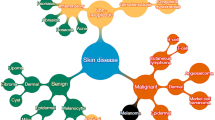Abstract
The prevalence of skin illnesses is higher than that of other diseases. Fungal infection, bacteria, allergies, viruses, genetic factors, and environmental factors are among important causative factors that have continuously escalated the degree and incidence of skin diseases. Medical technology based on lasers and photonics has made it possible to identify skin illnesses considerably more rapidly and correctly. However, the cost of such a diagnosis is currently limited and prohibitively high and restricted to developed areas. The present paper develops a holistic, critical, and important skin disease prediction system that utilizes machine learning and deep learning algorithms to accurately identify up to 20 different skin diseases with a high F1 score and efficiency. Deep learning algorithms like Xception, Inception-v3, Resnet50, DenseNet121, and Inception-ResNet-v2 were employed to accurately classify diseases based on the images. The training and testing have been performed on an enlarged dataset, and classification was performed for 20 diseases. The algorithm developed was free from any inherent bias and treated all classes equally. The present model, which was trained using the Xception algorithm, is highly efficient and accurate for 20 different skin conditions, with a dataset of over 10,000 photos. The developed system was able to classify 20 different dermatological diseases with high accuracy and precision.






Similar content being viewed by others
References
Chan S, Reddy V, Myers B et al (2020) Machine learning in dermatology: current applications, opportunities, and limitations. Dermatol Ther (Heidelb) 10(3):365–386. https://doi.org/10.1007/s13555-020-00372-0
Bandyopadhyay S, Bhaumik A, Poddar S (2021) Skin disease detection: machine learning vs deep learning. https://doi.org/10.20944/preprints202109.0209.v1
Wu H et al (2020) A deep learning, image based approach for automated diagnosis for inflammatory skin diseases. Ann Transl Med 8(9):581–581. https://doi.org/10.21037/atm.2020.04.39
Velasco J et al (2019) A smartphone-based skin disease classification using mobilenet CNN. Int J Adv Trends Comput Sci Eng 8(5):2632–2637. https://doi.org/10.30534/ijatcse/2019/116852019
Lee YC, Jung S-H, Won H-H (2018) WonDerM: skin lesion classification with fine-tuned neural networks. pp. 1–4 [Online]. Available: http://arxiv.org/abs/1808.03426
SSP, Leelavathy N, Jaichandran S et al (2020) Skin disease detection using computer vision and machine learning technique Eur J Mol Clin Med 7(4):2999– 3003
Cullell-Dalmau M, Noé S, Otero-Viñas M et al (2021) Convolutional neural network for skin lesion classification: understanding the fundamentals through hands-on learning. Front Med 8(March):1–8. https://doi.org/10.3389/fmed.2021.644327
Patnaik SK, Sidhu MS, Gehlot Y et al (2018) Automated skin disease identification using deep learning algorithm. Biomed Pharmacol J 11(3):1429–1436. https://doi.org/10.13005/bpj/1507
Srinivasu PN, Sivasai JG, Ijaz MF et al (2021) Networks with MobileNet V2 and LSTM 1–27
Alkolifi Alenezi NS (2019) A method of skin disease detection using image processing and machine learning. Procedia Comput Sci 163:85–92. https://doi.org/10.1016/j.procs.2019.12.090
Esteva A, Kuprel B, Novoa RA et al (2017) Dermatologist-level classification of skin cancer with deep neural networks. Nature 542:115–118
Haenssle HA, Fink C, Schneiderbauer R et al (2018) Man against machine: diagnostic performance of a deep learning convolutional neural network for dermoscopic melanoma recognition in comparison to 58 dermatologists. Ann Oncol 29:1836–1842
Masood A, Al-Jumaily AA (2013) Computer aided diagnostic support system for skin cancer: a review of techniques and algorithms. Int J Biomed Imaging 2013:323268
Burroni M, Corona R, Dell’Eva G et al (2004) Melanoma computer-aided diagnosis: reliability and feasibility study. Clin Cancer Res 10:1881–1886
Wighton P, Lee TK, Atkins MS (2008) Dermascopic hair disocclusion using inpainting. In Medical Imaging 2008: Image Processing, vol. 6914 of Proceedings of SPIE
Zhou H, Schaefer G, Sadka AH, Celebi ME (2009) Anisotropic mean shift based fuzzy C-means segmentation of dermoscopy images. IEEE J Sel Top Sign Proces 3(1):26–34
Abbas Q, Celebi ME, García IF (2011) Hair removal methods: a comparative study for dermoscopy images. Biomed Signal Process Control 6(4):395–404
Celebi ME, Kingravi HA, Aslandogan YA, Stoecker WV (2006) Detection of blue-white veil areas in dermoscopy images using machine learning techniques. In Medical Imaging 2006: Image Processing, vol. 6144 of Proceedings of SPIE
Mohammed SS, Al-Tuwaijari JM (2021) Skin disease classification system based on machine learning technique: a survey. IOP Conference Series: Mater Sci Eng 1076
Hashmani MA, Jameel SM, Rizvi SSH, Shukla S (2021) An adaptive federated machine learning-based intelligent system for skin disease detection: a step toward an intelligent dermoscopy device. Applied Sciences, Switzerland 11(5):1–19
Dildar M, Akram S, Irfan M et al (2021) Skin cancer detection: a review using deep learning techniques. Int J Environ Res Public Health
Author information
Authors and Affiliations
Corresponding author
Ethics declarations
Ethical approval
This article does not contain any studies with human participants or animals performed by any of the authors.
Conflict of interest
The authors declare no competing interests.
Additional information
Publisher's Note
Springer Nature remains neutral with regard to jurisdictional claims in published maps and institutional affiliations.
Impact statement
Dermatological illnesses have grown fairly common, and the expense of identifying them using sophisticated procedures is exorbitant. The current research proposes a low-cost and comprehensive solution based on deep learning algorithms that can distinguish between 20 distinct types of dermatological skin problems with high precision and accuracy over a large dataset of more than 10,000 photos.
Rights and permissions
Springer Nature or its licensor (e.g. a society or other partner) holds exclusive rights to this article under a publishing agreement with the author(s) or other rightsholder(s); author self-archiving of the accepted manuscript version of this article is solely governed by the terms of such publishing agreement and applicable law.
About this article
Cite this article
Fatima, N., Rizvi, S.A.M. & Rizvi, M.S.B.A. Dermatological disease prediction and diagnosis system using deep learning. Ir J Med Sci (2023). https://doi.org/10.1007/s11845-023-03578-1
Received:
Accepted:
Published:
DOI: https://doi.org/10.1007/s11845-023-03578-1




